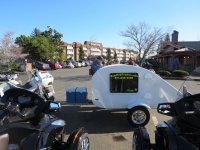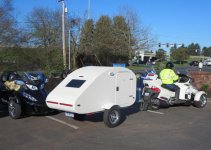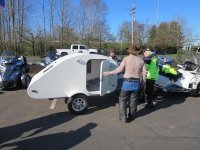-
There were many reasons for the change of the site software, the biggest was security. The age of the old software also meant no server updates for certain programs. There are many benefits to the new software, one of the biggest is the mobile functionality. Ill fix up some stuff in the coming days, we'll also try to get some of the old addons back or the data imported back into the site like the garage. To create a thread or to reply with a post is basically the same as it was in the prior software. The default style of the site is light colored, but i temporarily added a darker colored style, to change you can find a link at the bottom of the site.
You are using an out of date browser. It may not display this or other websites correctly.
You should upgrade or use an alternative browser.
You should upgrade or use an alternative browser.
only 270 lbs. !
- Thread starter easysuper
- Start date
Nice would love one of thoseSeen this at our club meeting this month . 40" wide inside all PVC body and aluminium frame.



Marker
Active member
Last edited:
BLUEKNIGHT911
Sadly Passed Oct 2024 - RIP
TRAILER
:agree:....That's sweet ...until you get to the price...........But that aside, I would have mounted the POD on the trailer ...in reverse of the way they did it ....for aerodynamic reasons .........I suppose you could do that if you bought it ????.........Mike
:agree:....That's sweet ...until you get to the price...........But that aside, I would have mounted the POD on the trailer ...in reverse of the way they did it ....for aerodynamic reasons .........I suppose you could do that if you bought it ????.........Mike
ARtraveler
R.I.P. Dwayne
Very nice trailer option. :thumbup::thumbup:
mrfats
New member
Seen this at our club meeting this month . 40" wide inside all PVC body and aluminium frame.



Your pics are better than their website...
Bob Denman
New member
It sort of looks like the Kissin' Cousin to the Little Guy trailers... :2thumbs:
IdahoMtnSpyder
Well-known member
Which edge of an airplane wing has the larger radius?But that aside, I would have mounted the POD on the trailer ...in reverse of the way they did it ....for aerodynamic reasons.
lightnin leeRoy
Member
Only 270 lbs.
Looks great.
Looks great.
wanderingman
New member
I am not sure how to attach prior comment but in response to Blue Knight, you are correct regarding the airplane wing, but that is not to reduce resistance, it is to achieve lift. It is an idea found by a guy named Bernouli. By his theory, the shape of this trailer through the air actually creates lift. I don't know if this is good or bad.
Bob Denman
New member
It may have been designed this way to insure that the bulk of the load is NOT ending up behind the axle...
PrairieSpyder
New member
I wonder if it floats! They could put the hatch in the top and it could be a houseboat! hyea:
hyea:
IdahoMtnSpyder
Well-known member
True, but reduction of resistance is part of the equation. There probably is some lift but it would be immaterially small. Air flowing around a blunt object produces a lot of turbulence on the downwind side. That turbulence creates a low pressure region which the pressure on the front side tends to push the object into. That is part of the drag of moving an object through air. Low pressure on the downwind side is why hurricane winds remove siding, including bricks, from a building. The low pressure is reduced by a design the allows the air to smoothly pass over and come back together with less turbulence.I am not sure how to attach prior comment but in response to Blue Knight, you are correct regarding the airplane wing, but that is not to reduce resistance, it is to achieve lift. It is an idea found by a guy named Bernouli. By his theory, the shape of this trailer through the air actually creates lift. I don't know if this is good or bad.
Reducing drag caused by turbulence is the idea behind the "Trailer Tail" you see on semi truck trailers these days.
camper
Airplane wings are designed to provide lift!!
Which edge of an airplane wing has the larger radius?
Airplane wings are designed to provide lift!!
Roadster Renovations
New member
Which edge of an airplane wing has the larger radius?
Yeah, but isn't that to create a vacuum to create lift. It does that by knocking the wind away from the top and bottom of the wing. More drag, not less and in this case exactly opposite of what you would want to do IMHO.
That is a sweet trailer, but a little too pricey.
IdahoMtnSpyder
Well-known member
Yes, but they depend on very smooth air flow to do so, not turbulent flow! You get the smooth flow by the elongated taper on the trailing side. Look at underwater torpedos. The front is blunt round. The back is tapered to a point. Same for bombs. Lift is not needed in either of those cases. There's a reason for the blunt front, tapered rear, - less drag.Airplane wings are designed to provide lift!!
Similar threads
- Replies
- 8
- Views
- 427
- Replies
- 6
- Views
- 2K
- Replies
- 1
- Views
- 342



